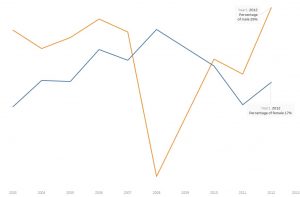
by dnk07 | Aug 7, 2022 | Dashboard
Countries with high death rates and relatively low fertility rates and birth rates may face a risk of population decline.
We explore through data visuals that developed countries have lower death rate than do developing countries. We understand the background by looking into various factors affecting this as hospital bed per capita, GDP per capita, health expenditure per capita and population growth rate. We use this knowledge to see which developing country requires an immediate call for action.
The highest mortality rates are seen in the African continent. Indeed, it is painful to see people dying in developing and poor countries where health care networks and facilities are less robust and people struggle to obtain basic needs such as clean water, adequate food and sanitation.
Death rate is highest in countries with lowest Hospital bed per Capita, lowest health expenditure per capita and lowest GDP per capita as per evidence for 10 countries (5 lowest death rate per 1000 capita Qatar, Kuwait, Bahrain, UAE and China) vs 5 Highest Death rate per 1000 capita (Sierra Leone, Chad, Mali, Niger and South Sudan) .

Nations and government should assist Africa to enhance their economic conditions to raise the GDP, to build hospitals to increase the bed capacity and increase health expenditure. Failure to do so may result in a population decline. Maps clearly show Africa shows very low GDP in addition to highest mortality rates.
But a clear plan is needed, in which country should we start improving and working on such factors. We suggest considering population decline as an urgent factor.
Population decline seems to be an issue and should be avoided especially in Sierra Leone Why?
Sierra Leone has the highest death rate. Yet, it is not among the countries with highest birth rate and highest fertility rate. Moreover, among the top 5 countries with highest mortality rates it is showing the least population growth. This seems a country of concern especially when it comes to population decline. Let us start here.
Please don’t forget that High Death rate in Africa is not about population in Africa.
To prove this, we consider China. China has very high population yet a very low death rate of 4.88 per 1000 people compared to 23.2 per 1000 people in Sierra Leone.
We cannot really control population and accept high death rates in populated countries. We need to:
- Enhance socioeconomic conditions and Governments need to invest in better GDPs in the healthcare system and to build hospitals to increase hospital per 1000 capita
- Increase awareness about hygiene
- Increase healthcare education

by sfh25 | Aug 7, 2022 | Dashboard
What is child labor? By definition is it any type of employment that prevents children from their childhood and dignity, and/or could be harmful to their physical or mental wellbeing.
Using the data collected from around the world and presented in the WDIData.csv I have tried to visualize child labor ratio. As you can see in below figure where child labor is presented on country level and the size of the dot indicates a higher ratio:

Children between 7 to 14 employement rate
Child labor affected both male and female children alike, as you can see in below figure:

Children between 7 to 14 employement rate – Male vs Female
Child labor is usually associated with:
- Wealth of the country (GDP per capita)
- Educational level
- Political conflict
- Government involvement and follow-up
Below figure, for example, shows an association between child labor and GDP per-capita (size of the dot represents the total population):

Percentage of children in employment vs GDP per capita in year 1962
What can we do to help children around the world?
To be able to address child labor we have to address all the points that contributes to it.
In my opinion, a good start will be with governmental support. Governments, for example, need to address this though issuing laws that prevents child labor below certain age.
Enhancing GDP is a long process and should be planned on country level. But a good start could be through controlling government expenditure and directing it to important areas only. Focusing on investing in infrastructure and support local productions vs imports.
Political conflict has to be addressed through serious piece discussions and cooperation with neighboring and world leading countries. And through strengthening the army and local forces and eliminating corruption.
Final thoughts
Child labor is one type of child abuse that should be addressed seriously. And although a lot of factors contributes to it that should be addressed there is one additional point that we might need to start with; which is the collection of data. Going through the WDIData.csv it is was clear to me that there is a lot of gaps over the years and on country level. And it is time to take the initiative and document child labor around the world properly. For children are the future of our race; they are the foundation on which we build our society. And it is very important to nurture them and protect their childhood.

by ame121 | Aug 7, 2022 | Uncategorized
Our topic of discussion is the Lebanese economic crisis which started by end of year 2019 with a total collapse of the public sector services and the dramatical currency devaluation which continues till today where the lebanese lira devaluated by almost 20 times since the crisis started.
In this post, I will shed light on indicators that shows the lebanse economy collapse, starting with the Gross Dometic Product GDP per capita in US dollars which is used to present economical prosperity over time, before and after the crisis. Moreover, we will see additional indicators over 5 years period the % growth rate of inflation in consumer prices as well as the % growth rate in income per capita in US dollars over time.
Starting with a helicopter view first on the Global GDP per capita trend showing the economic prosperity variances between developed regions (US & Canada, Europe and Australia) compared to emerging regions (Asia, Africa, and South America) with the intention to analyze deeper the MENA region and more specifically how is Lebanon ranking today compared to neighboring countries, and what has changed in the last few years since the people revolution started in 2019 and how the economy collapsed over time. MENA region with majority of countries shows low GDP per capita except oil exporting Arabian Peninsula countries. This region is a clear example of having the extreme mix of countries with Qatar having the highest GDP per capita in year 2021 $ 64K which can also be considered the highest globally and Yemen the lowest GDP per capita $ 0.7K which is also among the lowest in the world. Unfortunately, Lebanon economical position has deteriorated over the last 3-5 years and its position in the MENA region dropped form being 10 out of 20 to 14 out of 16 and the GDP per capita went down from $ 7.6K before crisis to $ 2.6K after crisis with a negative CAGR over 5 years(2016 to 2021) of 19%.
Moving now to aditional economic indicators:
- Inflation growth rate % in consumer prices in Lebanon was close to zero in 2016 until 2019 when the crisis started, and we witnessed since then a significant spike in growth rate % reaching 155% in year 2021
- The net income per capita indicator showed also a decline starting 2016 going with single digit negative growth YOY and reaching a negative 20% in 2020 with the economic crisis
- Double hit on the Lebanese consumer with an increased inflation growth & decreased net income per capita adding huge burden and leading to higher poverty rate
Lat but not least, a complete solution is needed to help overcome the Lebanese economic crisis which started in 2019 with urgent reformations in the public sector offered services along with political corrections that need to be done ASAP. Listing some of the basic yet crucial solutions to start with:
- The foundation of the solution should start with overcoming political rivalries to allow cooperation between different parties
- Experienced crisis team to be identified and empowered by the government
- Serious discussions on government debt restructuring
- Identifying a solution for the banking sector, specifically the bank deposits
- Stabilizing the exchange rate of Lebanese Lira which has devaluated for more than 20 times since year 2019
For complete visualization please access below link on Tableau Public: https://public.tableau.com/shared/SS7B85S94?:display_count=n&:origin=viz_share_link
For additional details and comments please refer to the PPT file below:
Lebanon Economic crisis

by ear06 | Aug 6, 2022 | Dashboard
Introduction
In this day and age, women are still vastly underrepresented at the top of business organizations, and also in the roles that lead to the top, progress has been slow even stalled over the last decade. Women should be empowered to walk up to senior positions. What are the pathways? What are the challenges? How to help the world achieve equality between men and women? What does it take to step up from being a technical or a functional expert, a great team leader to stepping up to a bigger, broader enterprise-wide role? What are the current facts and figures, and statistics on this topic?
Let us dive in.
Did you know?
In the U.S., women represent 47% of the workforce and in 40% of families, women are the primary or sole breadwinners.
Companies in the top quartile for gender diversity are 15% more likely to outperform the competition.
Women earn more bachelor’s, master’s, and doctoral degrees in the U.S. than men.
It has been reported that women control 70% of household spending, or $12 trillion, in developed countries around the world.
And yet…
Globally, women hold on average just 34% of senior leadership positions.
Women represent 45% of the S&P 500 workforce, but only 4% of the CEOs.
In a study of nearly 22,000 publicly traded organizations worldwide, 60% have no female board members!
What are the challenges?
Many challenges persist for women who aim for senior roles. While most organizations are seen to be putting effort into managing a more balanced gender diversity, there are still barriers faced by women, we mention the following:
- Women hold to higher standards; they are more detail oriented and need to do more than what men generally do to demonstrate that they are capable.
- A long way to fighting gender stereotypes, where general opinion says that men are better in doing certain jobs such as managing sports teams and in the oil & gas sector, while women are now more present in police jobs, engineers, etc.…. women should be recognized for similar skills sets as men.
- Women are not as experts as men in playing strategies and taking risks.
- Women are allegedly known to be emotionally driven while taking decisions.
- They are supposed to manage many roles within the family and multitask.
- They face harassment at work and a lack of role models.
- We see cultural and social restrictions in some countries.
- Cognitive bias in the process of hiring, promoting, rewarding, and recognizing skills.
- Lack of women’s self-confidence.
- Women are perceived as being overly aggressive when voicing their opinion.
How can this situation improve?
- Women need to learn how to be more self-confident and grab the chance in senior roles.
- Implementing fair and inclusive policies, rules, and regulations to encourage more diversity in the senior management place.
- Companies must realize the importance of having equally men and women on their top board as much as possible. It is now clearer that companies with more diverse workforces perform better financially and competitively.
- Mentoring and supporting women.
- Providing unbiased training and professional development courses to those charged with selecting potential candidates.
- Fostering a work culture where women are encouraged to take on leadership roles.
- Not to forget the many recently introduced university programs on this topic from prestigious business schools.
Visualizations and Analysis.
By looking at the data from World Development Indicators, specifically the index of “Female share of employment in senior and middle management (%)” we get the results in Tableau as below:
Edit | Women in Leadership – by Elsy Riachy (tableau.com)


It is clear that the global average for Women in Leadership (WIL) in 2020 reached 34% from 31% in 2010, a very slow increase. Additional efforts should be made to plan a 50% score 10 to 15 years from now.
Things to note…
Each one of us should be taking action to ensure that the world is moving towards a more inclusive workplace where women are empowered to lead and have the opportunity to develop and progress.
Different ideas and perspectives help for a more innovative world in business which will ensure growth in a sustainable way.
Quotes
“Diversity and Inclusion, which are the real grounds for creativity, must remain at the center of what we do”. ~Marco Bizzarri
“Our ability to reach unity in diversity will be the beauty and the test of our civilization”. ~ Mahatma Gandhi

by mba39 | Aug 5, 2022 | Dashboard, Uncategorized
Diseases have always been a main driver behind the increase in mortality rate at a global stage with variations in its indulgence and impact among different countries. Many of these diseases are chronic, incurable diseases such as: cancer, diabetes and many more that are widely spread and and is considered lethal.
Data and statistics proved the correctness of our statement as it was evident that there is a considerable variation among different countries when comparing the data trend of how mortality rate due to diseases (CVD, cancer, diabetes or CRD) fluctuated over time across many countries worldwide. The data was collected from people ageing between 30 and 70 to make sure the data collected was relevant. For simplification, I chose two countries (Lebanon and Germany) to compare how they performed over time in this certain aspect. The result was a considerable drop in the mortality rate due to such diseases in Germany (from 16.1% to 12.1%) compared to Lebanon that showed almost a neutral change over time (from 20.2% to 19.9%). This was reflected by a constantly higher life expectancy at birth in Germany as compared to Lebanon.
After analyzing the collected data from different perspectives, we were able to draw conclusions about certain factors that might have impacted and influenced this variation in the data trend between the two countries. Among these multiple factors were the R&D expenditure (as a % of GDP) and the GDP per capita (in current US$). After visualizing how these two aspects varied over time in the two mentioned countries, we noticed that Germany invested incrementally in developing its R&D over time compared to Lebanon that had no records in this area. This investment in R&D results in technological advancement that promotes and enhances many areas including the health sector and medications. Here, Germany has achieved a lot of improvement that in return guarantees a better healthcare system and environment as well. As for the GDP per capita, Germany has also evolved and elevated greatly (from $2,761 to $46,253) compared to Lebanon that scored very low in GDP per capita growth (from $1,234 to $4,650). This explains Germany’s much greater capacity and ability to undertake such R&D projects and investments which ultimately leads to better and healthier ways of living and hence, drives a drop in the mortality rate over time caused by such diseases.
For countries scoring very low in GDP such as Lebanon, it is recommended to look for other ways to fund such R&D projects in order to bring a change and enhance the living standards and environment and have a better control over such diseases.











